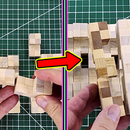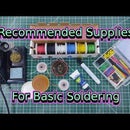Introduction: Using Flux | Soldering Basics
Whenever you're soldering, the solder needs to make a good bond to the parts that you're soldering onto. The metal of the parts and the metal of the solder need to come into direct contact with each other in order to create a good bond. But since metals naturally form an oxide layer because of the oxygen in the air, something is needed to remove that oxide layer. In my Instructable about using solder, I mentioned a little bit about flux, which works very well for removing that layer. Usually the solder that you use for electronics will already have flux within it, but it is also helpful to have flux available to use separately.
In this Instructable I'm demonstrating with some wires, but this information can also be used when applying solder to circuits. If you're interested in learning about some other aspects of soldering, you can check out the other Instructables in my Soldering Basics Series:
- Using Solder (Click Here)
- Using Flux (This one)
- Soldering Wires to Wires (Click Here)
- Soldering Through Hole Components (Click Here)
- Soldering Surface Mount Components (Click Here)
- Basic Desoldering (Click Here)
- Using Perfboard (Click Here)
- Required Tools and Supplies for Basic Soldering (Click Here)
- Recommended Tools for Basic Soldering (Click Here)
- Recommended Supplies for Basic Soldering (Coming Soon!)
I'm open to adding more topics to this series over time so if you have any suggestions, leave a comment and let me know. Also, if you have any tips to share, or if I get some of my info wrong, please let me know. I want to make sure this Instructable is as accurate and helpful as possible.
If you would like to see a video version of this Instructable, you can see that here: https://youtu.be/OWNAjwhwzro
Supplies
Here is what I used:
- Soldering Iron
- Helping Hands
- 22 gauge Wire
- Solder
- Flux
- Isopropyl Alcohol
- Cleaning Brush
Step 1: About the Oxide Layer
In these pictures I have some wires. The oxide layer on these wires is too thin to see, but it is still there. I already have some melted solder on my soldering iron (without flux). You can see that it does kind of stick to the wires, but it's mostly just sitting on the surface and not really bonding with the copper. As I move the solder around, it looks like it has some kind of skin on it. That skin is the oxide layer of the solder. The oxide layer is a barrier preventing the solder and copper from bonding together.
Step 2: Flux Removes the Oxide Layer
Flux is used to remove the oxide layer from the copper and from the solder. The way it does this is kind of interesting. It doesn't do much at low temperatures, but when it heats up and gets near the temperature of melted solder, it becomes corrosive and gets rid of the oxide layer.
Step 3: Soldering With Flux
The flux I used in these photos is a paste, but it can also be in different forms, like a liquid. When the solder on the iron comes into contact with the flux, it's like that solder skin just melts away. The solder gets shiny and behaves completely different when it touches the wires.
Also, as the flux melts and sizzles you can see the solder flow to the edge of the wires as it bonds to them. Instead of just sitting on top of the twisted wires, it has soaked down with the wires. Instead of looking crusty with a skin, the solder is shiny and looks wet. The shininess will go away as the solder cools down, but that's normal.
Step 4: Clean Off the Flux
There's another thing I want to mention about using flux. You can in these pictures that after I applied the solder, it looks like there's a burn mark on the board next to it. That's actually residue from the flux in the solder I used. Since flux is corrosive to the metals, it should be cleaned off. You can use isopropyl alcohol and scrub it off. I'm using a little scrub brush with it, but a cotton swab would work also. If you leave it on, it may affect things later on.
(Quick note: there are No-Clean fluxes available, which do not need to be cleaned off.)
Step 5: And That's It!
And that's the basics of using flux! As a quick summary, soldering can be complicated when you're trying to fight with the oxides on the wires and on the solder. Flux is used to remove that oxide layer so that the solder can bond to the wires. Flux is also a bit corrosive to the metals, so clean it off with isopropyl alcohol when you finish soldering.
Here are the other Instructables for my Soldering Basics Series:











